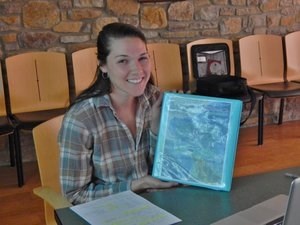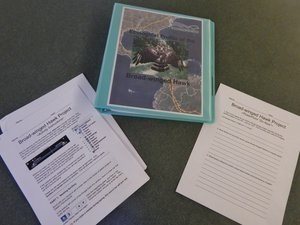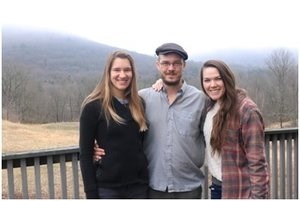Bridging the Gap of Research and Education
Posted on in On the Mountain by Kirsten Fuller, Education Intern
Hawk Mountain Sanctuary is a dynamic organization that uses educational programming in conjunction with scientific research to promote raptor conservation. As an education intern at the Sanctuary, I am proud to have completed a project that bridges the gap between these two distinct areas. Using my credentials in biology and education, and with guidance and support from various scientists and educators, I created a curriculum for high school students, which highlights scientific data collected by the Broad-winged Hawk Project at Hawk Mountain Sanctuary.

During my time as an intern at Hawk Mountain, I was also a student completing my bachelor's degree in education at Rowan University, and was enrolled in a writing intensive course structured around unit development. This turned out to be incredibly helpful for creating the Broad-winged Hawk curriculum. One topic heavily discussed in this course was the current reform in science education. Modern science teachers are expected to use an inquiry approach to teaching in tandem with technology in order to inform students about the nature of how science is conducted and how scientific discoveries have developed over time. A lot of the elements I learned from this course I was able to apply to the development of the curriculum. This made sure the curriculum is applicable in high school classrooms using these modern teaching approaches.
The curriculum is focused on a Broad-winged Hawk caught in New Ringgold, PA named Abbo. She was fitted with a satellite-tracking device in July of 2014, and was released to make her migration south. Broad-winged Hawks are known for making long migrations, on average between 8,000 and 10,000 km, from their breeding grounds in Eastern forests to wintering grounds in South America. Abbo migrated from her nesting site in Pennsylvania all the way to Brazil, and then back to Pennsylvania, where she chose a nest that was less than 30 km from her nest the year before. Points accumulated by satellites were collected in a database and then easily displayed on Google Earth Pro for visualization. This is the technology that students and teachers will use to complete activities in the curriculum.

In the curriculum, students explore the complete ecological profile of Abbo, the Broad-winged Hawk. Through a series of questions and guided instructions, students analyze and compare the ecology of the nesting grounds in Pennsylvania and the wintering grounds in Brazil, explore the migratory route taken by Abbo, and think critically about the conservation and preservation issues involved with this long-distance migrant. Content in the curriculum is applicable to many national and Pennsylvania State Standards for high school science education.
One aspect of the curriculum that I found really important was informing students of the way ecological research is conducted. I wanted students to understand how data about a species can be collected, and then how that data can be used to determine factors about that population. This is how we can begin to bridge the gap between research and education; by incorporating real-life scientific studies into traditional high school curricula, educators are able to hopefully inspire the next generation of biologists. I plan on using these techniques when I am a student teacher next fall.
Upon accepting the education intern position at Hawk Mountain, I was nervous about the challenges that I would encounter in my attempt to translate Broadwing migration data into an activity that is relevant in high school science classrooms. I am very excited to see it successfully implemented in the near future.

I don’t have a photo with all of the people who helped me complete this project, however seen with me to the left are Wouter Vansteelant and Zoey Greenberg, who both made my experience at Hawk Mountain fun and memorable. I am so thankful for the opportunity to spend time working for Hawk Mountain, and for all of the encouraging and knowledgeable people that helped me complete this project.
* This curricula with another on the black vulture was created with support from the Pennsylvania Wild Resources Conservation Program and other donors.